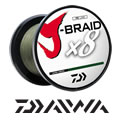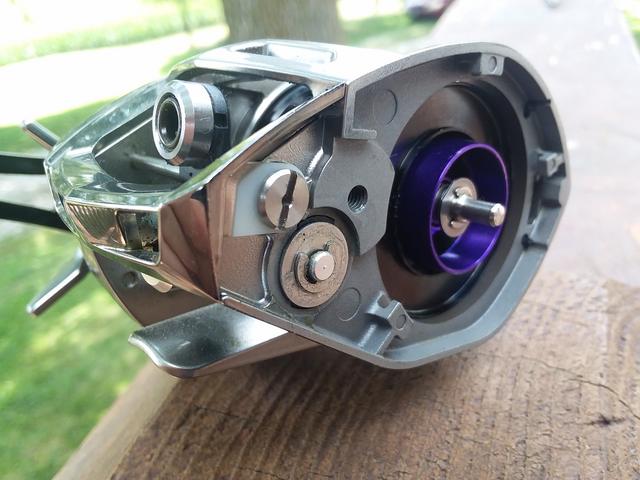I know a lot of folks here have mentioned how Lenz's Law, Faraday's induction, EMF, etc. were all governing the characteristics of the SV Boost system. And to be up front, these are all correct statements; however, I wanted to understand a little further and try to get the full relationships for things like braking torque as a function of spool speed, etc. So here's what I've learned...
Basic Principle of Braking System
So I know a lot of you are familiar with how the magnets that surround the inductor attached to the spool help generate an electromagnetic force that acts as a brake to slow down the spool by using Lenz's Law and things of that nature. But after doing a bunch of reading, the specific mechanism that is used in Daiwa's reels is referred to as a Dual Sided Permanent Magnet Radial Flux Eddy Current Braking System. It's a heck of a word salad to digest but each word is important, and you will often see the DSPM abbreviation when describing these systems.
Dual Sided - Refers to the fact that there is an inner layer and outer layer of magnets that surround the inside and outside of the inductor rotor, respectively.
Permanent Magnet - Refers to the fact that the magnets that surround the inductor rotor are not electromagnetically driven, they are permanent.
Radial Flux - Refers to the fact that the magnetic forces are acting radially, not axially, against the inductor rotor. This matters because there are DSPM braking systems based on Axial Fluxes as well as Radial Fluxes.
Eddy Current - Refers to the fact that the braking system generates Electromagnetic Eddy Currents in the inductive rotor to ultimately brake the rotor.
After doing a bunch of reading of the literature, I found three articles that do a very good job of explaining, in detail, how these systems work. I'll be referencing these three articles a good bit here:
(1) https://ietresearch.onlinelibrary.wiley ... .2013.0050
(2) https://ieeexplore.ieee.org/document/1381503
(3) https://link.springer.com/article/10.10 ... 017-0636-x
The starting point for describing a DSPM braking system is to consider the case where the spool has a constant angular velocity, the dial is set to maximum braking (setting 20 for my Zillion SV TW), and the inductor is fixed in a given position (i.e. - not moving in or out relative to the magnets). A general diagram of this is provided below and was taken from Reference (1).

This picture shows the basic outline of the inner and outer ring of magnets with a total of 12 magnetic poles (6 poles on the inner/outer ring, three 'N' and three 'S' poles per ring, total of 12 poles), and an inductor surface sitting in between the inner/outer rings.
I was able to verify that Daiwa used this setup for their braking system by removing the outer ring from my Zillion SV TW and running a small nail around the edge and counting the number of times the nail attracted/repelled from the ring. I put a picture of the ring below:

After doing this, I counted 6 total poles on the outer ring. Three 'N' and three "S" poles. I then verified that the inner ring had another 6 poles in a similar pattern so the setup matched the diagram in my first figure.
Once I was convinced that Daiwa was using the DSPM Radial Flux mechanism for their braking, I started studying the braking torque relationships as a function of spool speed for a fixed inductor setting. So to be clear, this would be the relationship between braking torque on the spool at a given spool speed assuming that the inductor does not move in or out. Reference (1) and (2) provides analytical relationships for Torque vs. spool speed with Reference (1) including a lot of important effects such as 3D shapes, reactions fields induced by the rotor, etc. That function is provided in the figure below:

When I first saw this formula, I really couldn't believe how complex it was and I was further shocked that Daiwa would need such a complex function to slow down a spool during a cast. For comparison, other braking systems usually have some simple linear, quadratic, or simple variation on those two functions to yield their braking torque vs. spool speed relationships. For a quick example on how crazy that function is, everywhere you see the parameter 'm' in that equation, that's another crazy function of spool speed that is defined in the Appendix of Reference (1). So spool speed is an insane combination of trigonometric, exponential, and hyperbolic functions as it relates to torque.
All three of the references provide a lot of figures that show what this function looks like for a lot of different combinations of magnets, inductors, speeds, geometry, etc. Here's one example below:

Looking at this figure (and a bunch of others), I started noticing that all of the curves can be broken into three separate sections. The first part, at the lower RPMs, is basically linear. As the RPMs get higher, there is a tapering off to a maximum. As the RPMs continue to increase beyond the maximum braking torque, the torque falls off and continues to fall until there is a point where RPMs are crazy high and braking torque is essentially nothing.
Reading further in Reference (1), I saw where they stated that the 'operational regime' of most DSPM's is in that linear range there at the lower RPMs. I even cropped a diagram from that paper that shows how they put a grey box around where they would expect the DSPM brake to actually be working. That picture is below:

Seeing this, it makes me wonder if Daiwa does something similar? I wonder if they designed their DSPM such that the torque relationship with spool speed remains in that linear range for a given inductor position and spool speed. If anybody knows for sure, I'd love to hear it.
Regardless, Daiwa gives us two ways to adjust the magnetic/electromagnetic field to change the overall braking profile. The first way is by giving us the dial on the outside of the reel that can go from 0 - 20 in settings. The next way is they allow the inductor to move in/out of the concentric permanent magnets as the spool speed increases/decreases, respectively.
I'll discuss the effect the dial has on the magnetic field first, and then the inductor moving in/out next.
Adjusting the Magnetic Field/Braking Dynamics With the Dial
For the longest time, I was convinced that turning outside dial on these SV Boost reels moved the magnets closer to/further from the spool. Boy was I wrong. What actually happens is that when you turn the dial, the outer ring of magnets rotates about the center of the spool shaft. If you go back to my second picture, you can see the gear toothed track that the outside ring has that connects to the dial.
Looking closer at the two magnet rings, I saw that there are two 'notches' in the plastic part of the rings. When the dial is at maximum (setting 20), these two notches line up. This is shown in the picture below. You can see the notches just above the two blue lines.

Next, I put the dial on minimum (setting 0) and marked the location of the notches again. You can see that the outside notch has rotated by looking at the figure below:

So what's happening here? If you go back to the very first picture I posted that shows a typical DSPM setup, it represents exactly what Daiwa has when the dial is set to the maximum braking setting. So all N magnetic poles on the inner ring line up exactly with an S pole on the outer ring.
When the dial is turned, this is not the case. The N poles from the inner ring will start to overlap with N-S poles from the outer ring. And when you get to the minimum brake setting, what you end up with is N poles from the inner ring lining up exactly with an N pole on the outer ring.
When the dial is set such that the N and S poles don't line up with each other (basically any other setting than 20), the magnetic flux gets reduced. This reduction in magnetic flux causes a reduction in electromagnetic flux generated by the inductor. This then reduces the amount of torque that the inductor can impart on the spool.
Now what I haven't been able to figure out yet is what effect the different dial settings has on the torque vs spool speed relationship. Is the formula I presented in the picture above still valid? Is there still a linear relationship, followed by a maximum, followed by a falloff of torque? If anybody knows the answer to this, I'd love to know.
One thing I am fairly certain of is that when the dial is at zero, and the N pole from the inner ring aligns with the N pole from the outer ring, the two current densities from the inner and outer magnets will cancel each other out and there would be no torque on the spool at any speed.
It's the blended N-S pole overlaps that I'm less sure about.
Adjusting the Magnetic Field/Braking Dynamics With the Inductor Rotor
The final way in which Daiwa manipulates the magnetic field to control the braking profile is that the inductor is attached to springs which will push the inductor in/out of the magnetic field at high/low spool speeds, respectively.
Below is a picture of how the inductor is installed on the spool shaft with the two springs that help control inductor position at various spool speeds.

You will notice the 'ramp' on the bottom of the inductor. That ramp fits flush with another ramp attached to the base of the spool. So when a torque is applied to the inductor rotor, the rotor will travel up the ramp until the springs are strong enough to either hold the inductor in place, or push the inductor back down to the base of the spool.
For the longest time, I was convinced that centrifugal force is what pushed the inductor into the magnets. Nope! It is the torque that is applied from the electromagnetic field that twists the inductor relative to the spool. That twisting is what then pushes the inductor into the magnetic field.
To prove this, I attached the spool to my Dremel drill and turned it up. The inductor did not move regardless of the speed of my Dremel. I took a video of this and if anybody has a YouTube account, I will email you the video to post. However, I did take a snapshot from the video and posted it below.

Hopefully, this photo helps show that the spool is spinning but the inductor is not extended at all.
Ok, to wrap this up. I was trying to figure out what Daiwa was trying to achieve by tying the position of the inductor to the torque generated by the electromagnetic field. And the best I can do at this point is the following thought experiment...
Put the dial back at maximum braking so the N-S and S-N poles are aligned. Now assume that the braking torque is a linear function of spool speed (from previous arguments). Now go back and look at that complex formula and notice that inductor length, L, is linearly related to torque. So by saying torque is a linear function of spool speed, and then further stating that inductor length is linearly related to torque, you can then say that torque would be a quadratic function of spool speed.
I plan on doing some more work on this. Namely, coding up the math to see what torque/speed curves look like for an actual Daiwa SV Boost spool. But if anybody has any more input, I'd love to hear it.
Hope this helps.

















